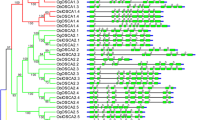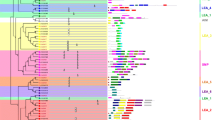Abstract
We performed a BLAST search of the rice database and screened four group 3 late embryogenesis abundant genes (OsG3LEA-47.3, OsG3LEA-41.9, OsG3LEA-20.5, and OsG3LEA-24.5) that shared characteristics of canonical G3LEAs such as multiple copies of consensus motif, hydrophilic, structural intrinsic disorder, thermostability, abscisic acid (ABA)-responsiveness, and high G and C content in gene sequence. Under nonstress conditions, OsG3LEA-20.5 and OsG3LEA-24.5 were constitutively expressed, whereas OsG3LEA-47.3 and OsG3LEA-41.9 were expressed in a stage- or tissue-specific manner. Transcripts of OsG3LEA-20.5 and OsG3LEA-24.5 accumulated under salt, ABA, and cold stress treatment. By contrast, OsG3LEA-47.3 and OsG3LEA-41.9 showed less responsiveness to stress in tillering and heading stages, respectively. All genes showed enhanced transcript levels after pollination and embryo development. To investigate the functions, we overexpressed OsG3LEA-47.3, OsG3LEA-41.9, OsG3LEA-20.5, and OsG3LEA-24.5 in Arabidopsis (47.3-ox, 41.9-ox, 20.5-ox, and 24.5-ox). Analysis of tolerance to drought stress revealed higher recovery after 14 days of dehydration treatment for 47.3-ox or 41.9-ox than the wild type (WT), 20.5-ox, or 24.5-ox. In addition, 47.3-ox and 24.5-ox plants showed higher survival than WT, 41.9-ox, and 20.5-ox plants under heat treatment, which induced similar expression patterns of heat shock protein genes in WT, 47.3-ox, 41.9-ox, 20.5-ox, and 24.5-ox plants. In vitro chaperone activity with the model substrate citrate synthase was comparable between OsG3LEA-47.3 and OsHSP16.9A, a rice molecular chaperone providing thermoprotection in vivo and in vitro. These results suggest that rice G3LEAs share many physical and biological features but function in contrasting ways.








Similar content being viewed by others
Abbreviations
- ABA:
-
Abscisic acid
- CS:
-
Citrate synthase
- GFP:
-
Green fluorescence protein
- HS:
-
Heat shock
- HSPs:
-
Heat shock proteins
- IPTG:
-
Isopropyl-β-d-thiogalactopyranoside
- LEAs:
-
Late embryogenesis abundant proteins
- RCBF2 :
-
C-repeated binding factor 2 gene
- WT:
-
Wild type
References
Bai Y, Yang Q, Kang J, Sun Y, Gruber M, Chao Y (2012) Isolation and functional characterization of a Medicago sativa L. gene, MsLEA3-1. Mol Biol Rep 39:2883–2892
Bies-Etheve N, Gaubier-Comella P, Debures A, Lasserre E, Jobet E, Raynal M, Cooke R, Delseny M (2008) Inventory, evolution and expression profiling diversity of the LEA (late embryogenesis abundant) protein gene family in Arabidopsis thaliana. Plant Mol Biol 67:107–124
Bray EA (1993) Molecular responses to water deficit. Plant Physiol 103:1035–1040
Candat A, Paszkiewicz G, Neveu M, Gautier R, Logan DC, Avelange-Macherel MH, Macherel D (2014) The ubiquitous distribution of late embryogenesis abundant proteins across cell compartments in Arabidopsis offers tailored protection against abiotic stress. Plant Cell 26:3148–3166
Chang CC, Huang PS, Lin HR, Lu CH (2007) Transactivation of protein expression by rice HSP101 in planta and using Hsp101 as a selection marker for transformation. Plant Cell Physiol 48:1098–1107
Clough SJ, Bent AF (1998) Floral dip: a simplified method for Agrobacterium-mediated transformation of Arabidopsis thaliana. Plant J 16:735–743
Deng W, Wang Y, Liu Z, Cheng H, Xue Y (2014) HemI: a toolkit for illustrating heatmaps. PLoS One 7, e111988
Dosztanyi Z, Csizmok V, Tompa P, Simon I (2005) IUPred: web server for the prediction of intrinsically unstructured regions of proteins based on estimated energy content. Bioinformatics 21:3433–3434
Dure L 3rd (1993) A repeating 11-mer amino acid motif and plant desiccation. Plant J 3:363–369
Galau GA, Hughes DW (1987) Coordinate accumulation of homeologous transcripts of seven cotton Lea gene families during embryogenesis and germination. Dev Biol 123:213–221
Goyal K, Tisi L, Basran A, Browne J, Burnell A, Zurdo J, Tunnacliffe A (2003) Transition from natively unfolded to folded state induced by desiccation in an anhydrobiotic nematode protein. J Biol Chem 278:12977–12984
Goyal K, Walton LJ, Tunnacliffe A (2005) LEA proteins prevent protein aggregation due to water stress. Biochem J 388:151–157
Guan JC, Yeh CH, Lin YP, Ke YT, Chen MT, You JW, Liu YH, Lu CA, Wu SJ, Lin CY (2010) A 9 bp cis-element in the promoters of class I small heat shock protein genes on chromosome 3 in rice mediates L-azetidine-2-carboxylic acid and heat shock responses. J Exp Bot 61:4249–4261
Hong B, Uknes SJ, Ho TH (1988) Cloning and characterization of a cDNA encoding a mRNA rapidly-induced by ABA in barley aleurone layers. Plant Mol Biol 11:495–506
Hong B, Barg R, Ho TH (1992) Developmental and organ-specific expression of an ABA- and stress-induced protein in barley. Plant Mol Biol 18:663–674
Hwang I, Sheen J (2001) Two-component circuitry in Arabidopsis cytokinin signal transduction. Nature 413:383–389
Jagadish SV, Muthurajan R, Oane R, Wheeler TR, Heuer S, Bennett J, Craufurd PQ (2010) Physiological and proteomic approaches to address heat tolerance during anthesis in rice (Oryza sativa L.). J Exp Bot 61:143–156
Jaspard E, Macherel D, Hunault G (2012) Computational and statistical analyses of amino acid usage and physico-chemical properties of the twelve late embryogenesis abundant protein classes. PLoS One 7, e36968
Koag MC, Fenton RD, Wilkens S, Close TJ (2003) The binding of maize DHN1 to lipid vesicles. Gain of structure and lipid specificity. Plant Physiol 131:309–316
Kyte J, Doolittle RF (1982) A simple method for displaying the hydropathic character of a protein. J Mol Biol 157:105–132
Lee YJ, Kim DH, Kim YW, Hwang I (2001) Identification of a signal that distinguishes between the chloroplast outer envelope membrane and the endomembrane system in vivo. Plant Cell 13:2175–2190
Lisse T, Bartels D, Kalbitzer HR, Jaenicke R (1996) The recombinant dehydrin-like desiccation stress protein from the resurrection plant Craterostigma plantagineum displays no defined three-dimensional structure in its native state. Biol Chem 377:555–561
Liu JG, Zhang Z, Qin QL, Peng RH, Xiong AS, Chen JM, Xu F, Zhu H, Yao QH (2007) Isolated and characterization of a cDNA encoding ethylene-responsive element binding protein (EREBP)/AP2-type protein, RCBF2, in Oryza sativa L. Biotechnol Lett 29:165–173
Machuka J, Bashiardes S, Ruben E, Spooner K, Cuming A, Knight C, Cove D (1999) Sequence analysis of expressed sequence tags from an ABA-treated cDNA library identifies stress response genes in the moss Physcomitrella patens. Plant Cell Physiol 40:378–387
Moons A, De Keyser A, Van Montagu M (1997) A group 3 LEA cDNA of rice, responsive to abscisic acid, but not to jasmonic acid, shows variety-specific differences in salt stress response. Gene 191:197–204
Pazos F, Pietrosemoli N, Garcia-Martin JA, Solano R (2013) Protein intrinsic disorder in plants. Front Plant Sci 4:363
Premachandra GS, Saneoka H, Ogata S (1990) Cell membrane stability an indicator of drought tolerance as affected by applied nitrogen in soybean. J Agri Sci 115:63–66
Roberts JK, DeSimone NA, Lingle WL, Dure L 3rd (1993) Cellular concentrations and uniformity of cell-type accumulation of two lea proteins in cotton embryos. Plant Cell 5:769–780
Solomon A, Salomon R, Paperna I, Glazer I (2000) Desiccation stress of entomopathogenic nematodes induces the accumulation of a novel heat-stable protein. Parasitology 121:409–416
Soulages JL, Kim K, Walters C, Cushman JC (2002) Temperature-induced extended helix/random coil transitions in a group 1 late embryogenesis-abundant protein from soybean. Plant Physiol 128:822–832
Soulages JL, Kim K, Arrese EL, Walters C, Cushman JC (2003) Conformation of a group 2 late embryogenesis abundant protein from soybean. Evidence of poly (L-proline)-type II structure. Plant Physiol 131:963–975
Stacy RA, Aalen RB (1998) Identification of sequence homology between the internal hydrophilic repeated motifs of group 1 late-embryogenesis-abundant proteins in plants and hydrophilic repeats of the general stress protein GsiB of Bacillus subtilis. Planta 206:476–478
Tompa P (2002) Intrinsically unstructured proteins. Trends Biochem Sci 27:527–533
Tunnacliffe A, Wise MJ (2007) The continuing conundrum of the LEA proteins. Naturwissenschaften 94:791–812
Wise MJ, Tunnacliffe A (2004) POPP the question: what do LEA proteins do? Trends Plant Sci 9:13–17
Xu D, Duan X, Wang B, Hong B, Ho T, Wu R (1996) Expression of a late embryogenesis abundant protein gene, HVA1, from barley confers tolerance to water deficit and salt stress in transgenic rice. Plant Physiol 110:249–257
Yeh CH, Chang PF, Yeh KW, Lin WC, Chen YM, Lin CY (1997) Expression of a gene encoding a 16.9-kDa heat-shock protein, Oshsp16.9, in Escherichia coli enhances thermotolerance. Proc Natl Acad Sci U S A 94:10967–10972
Yeh CH, Chen YM, Lin CY (2002) Functional regions of rice heat shock protein, Oshsp16.9, required for conferring thermotolerance in Escherichia coli. Plant Physiol 128:661–668
Acknowledgments
This work was supported by the National Science Council, Taiwan, ROC (no. NSC97-2313-B-008-001-MY3) to CH Yeh.
Author information
Authors and Affiliations
Corresponding author
Electronic supplementary material
Below is the link to the electronic supplementary material.
Supplementary Table S1
Oligonucleotides used in RT-PCR and coding region (CD) cloning. (DOCX 15 kb)
Supplementary Fig. S1
Hydropathy profiles for the deduced rice group 3 LEA proteins OsG3LEA-47.3, OsG3LEA-41.9, OsG3LEA-20.5, and OsG3LEA-24.5. (PPTX 296 kb)
Supplementary Fig. S2
Schematic representation of the structural features of the deduced rice group 3 LEA proteins OsG3LEA-47.3, OsG3LEA-41.9, OsG3LEA-20.5, and OsG3LEA-24.5. The disorder prediction agrees with the standard 0.5 threshold. (PPTX 120 kb)
Supplementary Fig. S3
The growth stage and sampling points in TNG67. (PPTX 151 kb)
Supplementary Fig. S4
Overall appearance of Col-0 WT and OsG3LEA-47.3 Arabidopsis transgenic plants grown on soil for 24 days at 23oC. (PPTX 557 kb)
Supplementary Fig. S5
Leaf number at flowering of OsG3LEA-41.9 transgenic Arabidopsis plants. (PPTX 53 kb)
Supplementary Fig. S6
Concentrations of OsG3LEA-47.3 with citrate synthase (CS)under 43oC. (PPTX 118 kb)
Rights and permissions
About this article
Cite this article
Ke, YT., Lu, CA., Wu, SJ. et al. Characterization of Rice Group 3 LEA Genes in Developmental Stages and Under Abiotic Stress. Plant Mol Biol Rep 34, 1003–1015 (2016). https://doi.org/10.1007/s11105-016-0983-1
Published:
Issue Date:
DOI: https://doi.org/10.1007/s11105-016-0983-1




